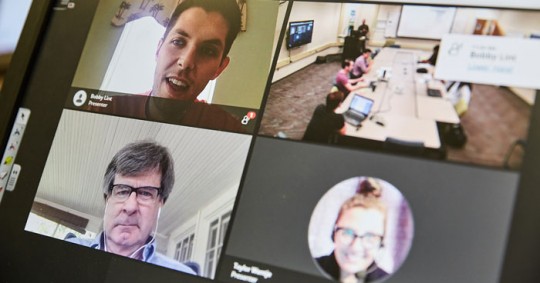Exercise Science Students Stretch Innovation Beyond The Classroom
April 30, 2020
For Dr. Amy Crawley, who teaches in the exercise science program, stretching the boundaries of a traditional classroom environment is par for the course. When the COVID-19 pandemic prompted the University of West Florida to transition the entire campus to remote instruction for the last half of the Spring 2020 semester, she was prepared to rise to the challenge, testing her innovative teaching abilities even further.
Dr. Crawley teaches Aging and Physical Performance, a practicum course designed to assist exercise science majors in developing an understanding of the complex physiological and psychological changes which accompany advancing aging and subsequent physical behavior.
In addition to completing traditional written and practical exams, students gain hands-on experience by individually prescribing, supervising and evaluating an eight-week strength training program with a local volunteer over the age of 65.
“The aging course is unique in that it already happens outside the boundaries of the traditional classroom,” Crawley said. “The educative growth and development in this course happens through the relationship developed between the student and their senior volunteer. The course has to be managed in a way that develops a student’s professional capacity, while providing a needed service to our local seniors. This experience is enhanced by the sense of community developed by the students and seniors as they become partners in learning and working towards a common goal.”
As the news of the University’s transition to remote instruction broke, students were just starting the strength training portion of the course, utilizing the weight room in the Health, Leisure and Sports Facility. Between training sessions, they were confronted with the reality that they would need to approach their training program in a new format, with new challenges.
“We didn’t know exactly how we would continue to deliver the training experience, but we did know we would try every virtual trick in the book to stay and on schedule and continue to provide this service,” Crawley said. “I asked students to transition their training to online but didn’t dictate how that would happen, as each senior volunteer might require a different approach to make it work. Some students have used email, YouTube videos, texting, and phone calls, while others have used Facetime, Skype, and Facebook Messenger. Each student did their best to keep their senior moving with our two-day-a-week schedule, and some even upped their senior’s training to four days a week. Many students have said they text or chat with their senior almost every day, knowing how important it is to have that social connection right now.”
Before this semester, senior exercise science major Georgia Spafford said she didn’t consider herself a “virtual fitness” person. She said her experience so far has changed her perspective on workouts outside of the gym, as she’s adapted to meet her senior volunteer’s needs.
“Getting the ball rolling was the hardest part,” she said. “The first day, I dropped off some equipment I had at home and scoped out what he already had so that I could build his workout plan accordingly. I’ve kept it simple so he can maneuver around it pretty easily, creating eight workouts on a basic chart. I didn’t think I would like this as much as I do, but it’s helped me relate so much more to professionals in our field who lead virtual workouts.”
Dr. Crawley said overall, the feedback she’s received from students has been enthusiastic, creative and caring.
“These students have demonstrated that to be an effective professional in exercise science they have to ‘care’ to ‘take care’ of the person they serve,” she said. “I couldn’t be more proud of how well they handled this virtual educative experience.”




Comments